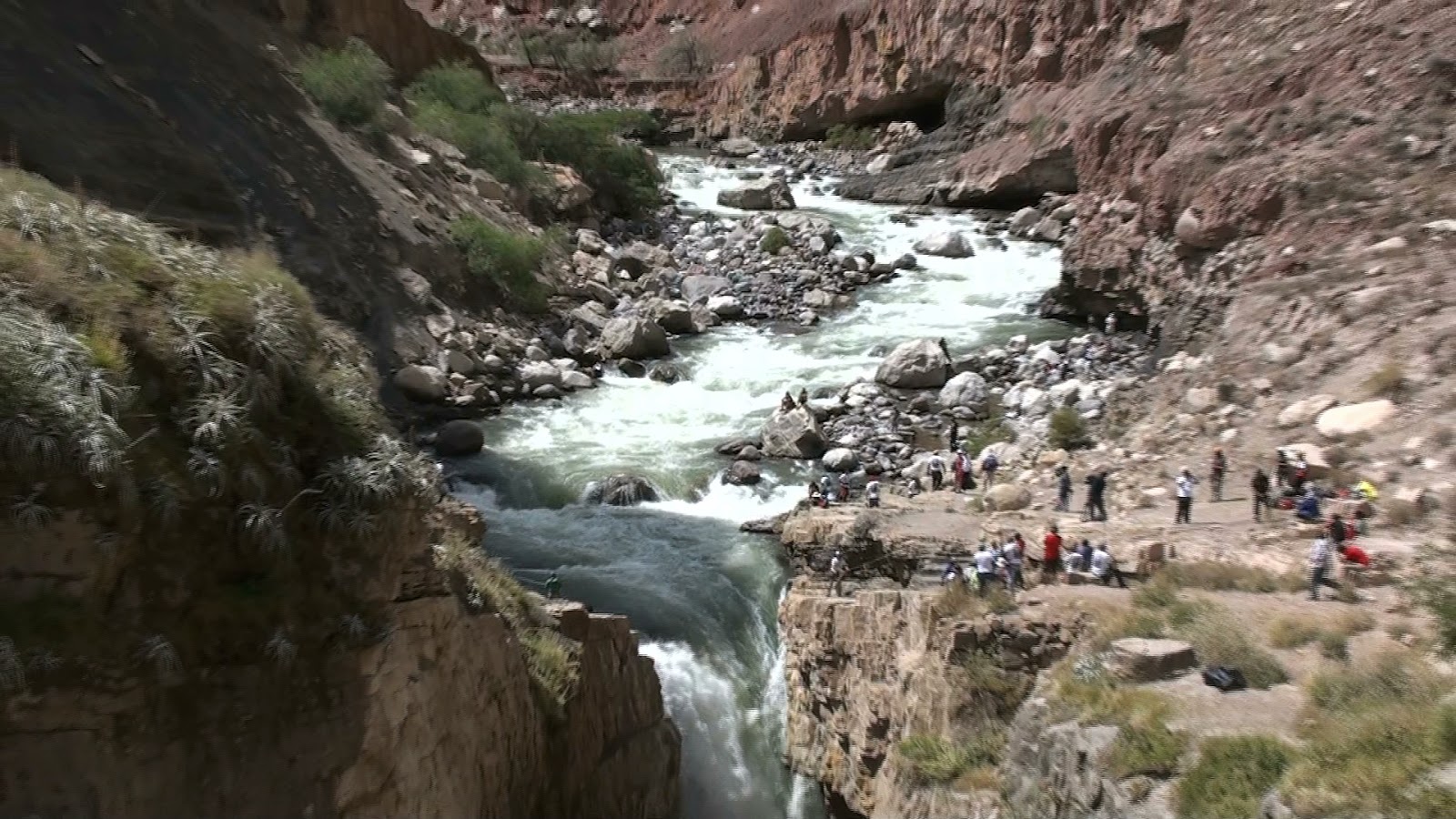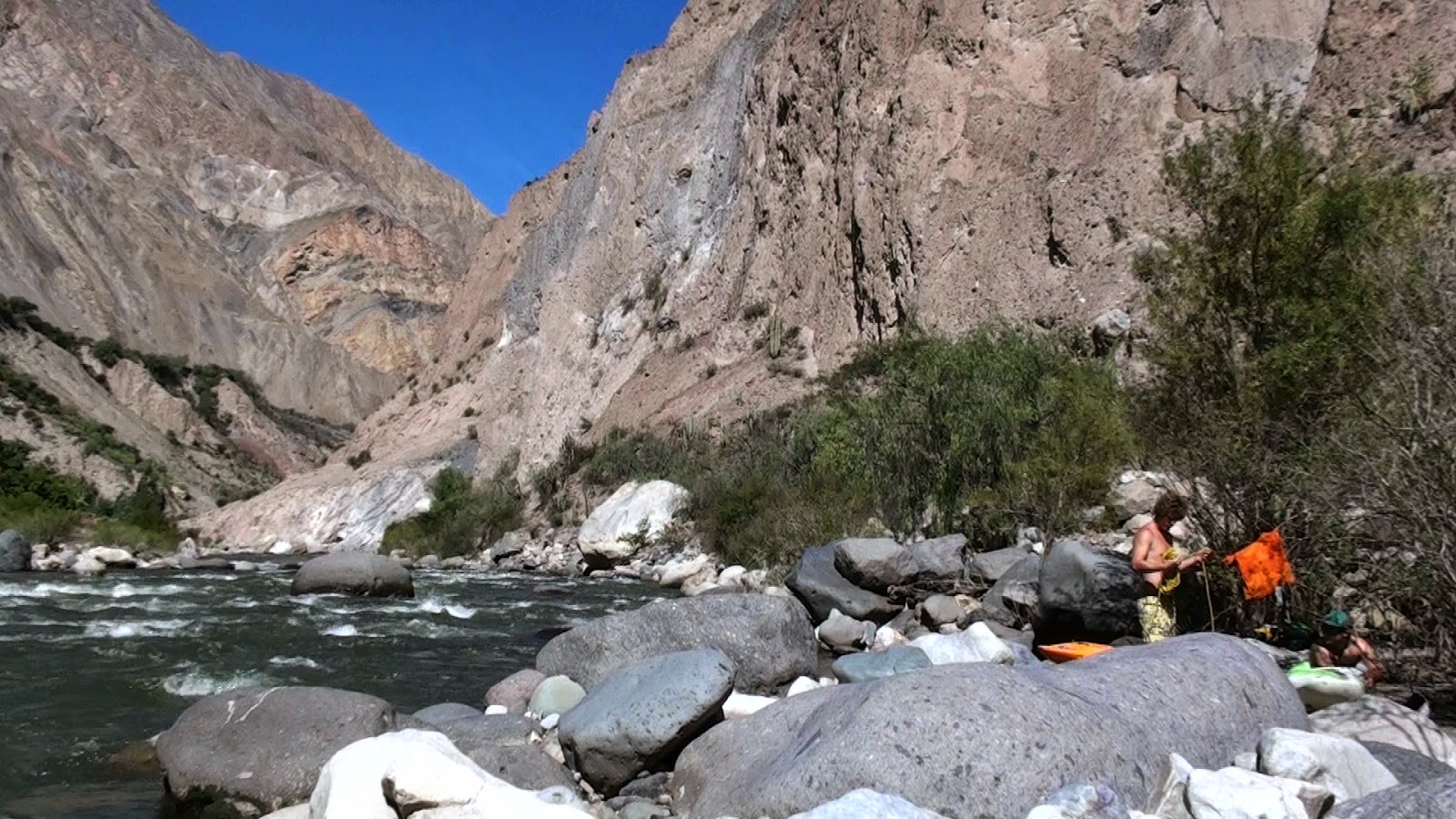Cotahuasi and Colca
Almost three days in Arequipa slowed the pace of kayaking but not decreased at all the excitement.
Our boats were sent as cargo the day before to the village of Cotahuasi, tonight it was our turn to travel the 400 km (approximately).
The journey was around 9 hours to our destination. The "road" is endless zigzags up and downhill, touching points of 4500 meters and as if that were not enough is a dirt road in bad shape; the vertigo you felt every time the bus took a sharp turn and the road was lost in the night was only surpassed by the sense of repeatedly fly out of your seat every time the bus could not dodge any of the thousands potholes scattered on the "track".
I think it goes without saying that little or no sleep tonight, but “to a gift horse we don´t look its teeth". We were invited to the festival of eco-adventure organized by the village of Cotahuasi, Dani had made contact and had transportation, food and lodging organized only for attending; an undeniable deal.
View of Cotahuasi town on the way to Sipia Falls
We stayed in the "Hostal Chavez" a humble inn with adobe walls painted with lime water, the central courtyard was decorated with small quinchos made of straw and sticks.
The room did not appear less than a presidential suite before our eyes, much more after our trip, and in our faces you could see the desire to enjoy the confort that was shown to us.
Our bubble blow at the shout of "hurry gentlemen” was the “seño”(miss) Eba, one of the organizers who pointed us in the direction towards the exit.
Cotahuasi
On the road to Sipia (one hour from the village) we appreciate the rapids of the upper Cotahuasi a Peruvian "non-stop". Endless labyrinths of "boulder gardens" with a large slope. The section has been navigated before but never with these water levels.
Sipia waterfall is a waterfall about 100 mts divided into three jumps, the first of them surely Class VI as the water ends its free flight on a huge boulders creating great bursts of foam. The other two jumps are possible although access would be through a rappel and did not stop being intimidating.
At noon we decided to go back to town and take a rest preparing for our upcoming days.
The next morning, we prepare with the rest of the people participating in the festival and head towards the upper part of Cotahuasi; the plan, conduct a rafting tour in this section of the river and end up in the hot springs of "Luicho".
In the put-in we find some cameramen and journalists who did not lose the opportunity to interview Andrew and Evan, the "gringos" of the expedition, and also the ones giving the little "show" when jumped into the water from the bridge on their kayaks, something that the locals do not see often.
The descent was beautiful, following the river as it winds through small villages and cultivated fields, only class II all the way and take-out exactly at the hot springs of Luicho where we had a good time enjoying, then back to the hostel, a good dinner and rest, tomorrow we finally begin our expedition.
Early in the morning our shuttle was waiting on the doorstep. The plan was that the car would take us to the put-in of the section upstream of Sipia from where we would try to get paddling down to the waterfall and then would continue journey to where we would begin our journey of three days in the canyon of Cotahuasi.
As soon as we started paddling the gradient increased and began continuous class V. We have advanced about 2 km in just over 2 hours. We mainly had to stay on the banks, the center of the river was littered with large rocks that created endless labyrinths in which abounded siphons and "undercuts".
Reaching the halfway we find one of the drivers on the banks of the river, we had taken much longer than we planned and was not part of the agreement the amount of time we were taking. At that point we decided to call off this part of the descent and continue on foot to reach the bus.
Once in the bus we start the way to Velinga where we begin three days section. The trip over the river is not very long between the waterfall and the starting point, but down the road takes about an hour.
The canyon is incredibly beautiful, endless walls of different brown tones whose colors change according to different strata and minerals that are exposed to the surface. Ocher, yellow, orange and red highlight between the different layers of brown, also the immensity of this place made us feel small and immersed in this raw nature. Our vehicle was approaching the roadside where a fall from 1000 mts awaited a bad maneuver of our driver, but we didn´t had to worry about it because this trip was well known to our "ride", however all of us doubted that two vehicles in opposite directions succeed in passing through the narrow dirt road.
Formerly the road only reaches a few kilometers from the village of Velinga where a descent of about 9 hours with mule used to began to reach the riverbank, this time the bus dropped us off at the town over the river banks where we only had to cross to the right margin with our kayaks and our camping equipment to stay for the night and wait for Santiago to arrive the next day. Our first night in the Cotahuasi River.
Commercial Section of Cotahuasi
The next morning Santiago arrive early and thus began paddling. The Cotahuasi river is generally a river of class III and IV rapids with some that can be classified as V. Meanders toward the Pacific Ocean and on its passage there are vestiges of the Wari and Inca cultures, which used the river as a way of communication with the Pacific.
Throughout the trip you can see great vestiges of cultures that once inhabited the place, lots of terraces line the riverside and mountain ridges. Unthinkable places with a very difficult access are populated of this terraces that at some time probably contained large quantities of crops; a complicated system of "canals" (channels made of stone) which drained the different layers of terraces through slopes, without using nothing but gravity and intelligence.
Our first campsite would be after "Marpa" and just before the "Canyon Metro", named because here is one of the places where the canyon gets more narrow. Without realizing it we had advanced enough in the river and were much more into the Canyon than we had thought, at that time we decided to try to finish the next day to head immediately to the Put-In of Colca River which was our next target. With this in mind we went to rest until the next day.
The rest of the expedition went smoothly, paddled from morning to 6 pm to reach the Take-Out where we waited a few hours until we meet Daniel´s father with his Toyota Land Cruiser, the perfect vehicle for the journey that would take us right at the entrance of the Colca.
Colca
From the Take-Ot of Cotahuasi we move in small gravel roads and tracks, at some point Dani's father decided to take a small "shortcut" that introduced into unknown lands to all and in a small dirt road in a very bad state, luckily the Land Cruiser was ready for everything and the poor state of the trace was no problem for this 4x4 vehicle. After 12 hours of drive and already 4 am in the morning of the next day, we arrived at what would be the Put -In of the Colca river where we lie to reconcile some sleep and rest before dawn.
The morning was not slow when you consider the time when we had arrived; at 9 am we had everything ready to start down the river, formerly it was a path of difficult access but we found that workers had created a trail well marked, it was not a "walk in the park", but really the access to the river was quite simple. The footprint was made to carry pipes and they were building a dam on the Mamacocha river, a tributary of the Colca, at that point is where the real action starts. Formerly the entrance to the canyon was from the left bank of the river reaching the town of Canco but due to recent construction a new road reaches the right margin from which access was provided.
Since we were doing a very good time we determined to finish the descent in one day and we got in the water; Colca Canyon extends parallel to the Cotahuasi and their formations are similar although the lack of construction makes it look like a much more rugged and inhospitable place, a cruder nature. Also used as a communication route to the Pacific, but less because of its inaccessibility, large vertical walls made it impossible to develop habitable places or areas of crops unlike his brother the Cotahuasi. Large portions of basaltic rock stand in sight as we enter one of the deepest canyons in the world. Giants vertical walls rise to the heavens above showing the great peaks, some of them above 6000mts high, surrounding this place.
Santiago showing us his country
The great knowledge that Santiago and Dani have of the river allowed us to move smoothly, not only that but it also helped us learn about the history of this river that relates to the history of the exploration of rivers in Peru.
The Colca River and Cotahuasi are full of stories closely related to the first explorers of Peru the Ibañes and the Vellutinos, families linked to water to their land and river in general, generations of explorers who brought the sport and passion for that connection with nature in their blood; that special community that people river feels and leads us to explore the veins of our planet, to venture into inhospitable places looking for a response that will never come because the exploration can not cease, once completed or exhausted a place a new horizon line rices, a new idea, a new challenge, a new adventure appears ….
Desert Fish















